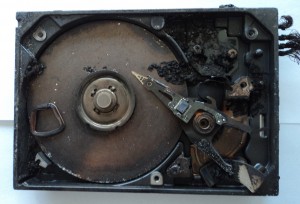A quick online search will throw up all manner ideas about how to securely deal with data on an old hard drive, but let’s just say you shouldn’t believe everything you read. No matter how creative the solutions, they consistently fail to meet the equally important goals of removing data securely, safely and responsibly. Let’s run down some approaches you really should skip.
Delete And Reformat
The simplest “solution” has a big problem: despite the name, deleting files doesn’t usually physically remove them. Instead the computer simply removes any reference to them in its “map” of the hard drive (known as an address table). The files will still be there – ready for a scammer to retrieve – until the computer needs to reuse that specific location on the drive.
And don’t think reformatting is a foolproof solution either. The reason you can reformat a traditional drive in a matter of moments is that the computer isn’t deleting any files, just wiping out the address tables.
In theory, reformatting an SSD will indeed remove all files permanently, though you need to use the right software to be certain. The process is also fairly taxing on the drive, so it’s not a perfect option if you want to reuse it.
Use Free Wiping Software
This is one step up from deletion and reformatting, but still far from perfect. While the brand names vary, most software uses the same approach and it’s nothing more complicated than writing a string of zeroes until the drive is full, then reformatting. This will usually do the trick with modern SATA (mechanical) drives, though it won’t meet all government security standards and can be time-consuming. Unfortunately it doesn’t work with Solid State Drives as some areas are protected from such wiping.
Smash It Up With A Hammer
In theory this will be effective as long as you hit it hard enough to shatter the disk platter inside so that it can’t be read. This isn’t as easy as it sounds as either you have to dent the metal casing or remove it (often a fiddly process) and then risk sharp pieces of the platter hitting you or a loved one. (The hammering is also a great way to get a thumb blister.)
Burn It With a Torch

The platters of a fire-damaged drive.
To burn through the casing to the platter itself (which physically holds the data) and then melt the platter (often made of glass or ceramics), you’re looking at a very high temperature for a long time, which is dangerous enough in itself. Throw in the prospect of toxic fumes from materials such as cadmium and lead and this method is clearly not one for bright sparks.
Melt It With a Torch
We have to be honest on this one: submerge a hard drive in the right chemicals and the data will certainly become irretrievable. However, so might anything in close vicinity given the very serious risk of explosion or fume inhalation. Even if you and your facilities make it through unscathed, your next environmental impact assessment is not going to make pretty reading.
Throw It In The Trash
“Do I feel lucky?” Well, do you, punk?
This is certainly a good method if you believe fortune favors the brave. If everything goes to plan, your drive will either be crushed beyond repair or find its way to the bottom of landfill, not to be discovered until it’s dug up by our descendants in a post-apocalyptic wasteland. The problem is that at any stage in this process the disk could be retrieved by a scammer, either trying their luck or specifically targeting your business.
Zap it with a Magnet!
This is definitely a tactic taken from the “It stands to reason” playbook. The logic has it that a hard drive uses magnetic fields, so a powerful magnet can mess it up. (Straight away you can discount SSDs from this approach as they have no moving parts or magnetic fields.)
It’s a logic that doesn’t stand up to a few moments of thought. The arm inside a hard drive which physically moves the read head to the specific location of a file’s data is itself powered by a powerful magnet… and yet hard drives still work. Check any report of people who’ve actually tried this “trick” and they’ll mention their surprise when even a powerful magnet failed to do the trick.
Choosing a Professional
Almost any approach you use to try to secure an old hard drive will be ineffective or impractical. The only real solution is a secure data destruction service from a professional expert. The big advantage here is that not only are you left confident the data really is irretrievable, but an expert can make sure the destruction (and thus the security protection) complies with all applicable federal laws and codes of practice.
Datarecovery.com is just such an expert with a particular benefit: because we’ve done so much work recovering data from faulty or compromised drives, we know exactly what it takes to make recovery impossible. Call 1.800.237.4200 today and we’ll help you find a genuinely safe and secure solution.




